An interview with Amanda McMillan OBE, Managing Director, Glasgow Airport, CEO AGS Airports (which includes the airports of Aberdeen and Southampton). By Paul Hogan
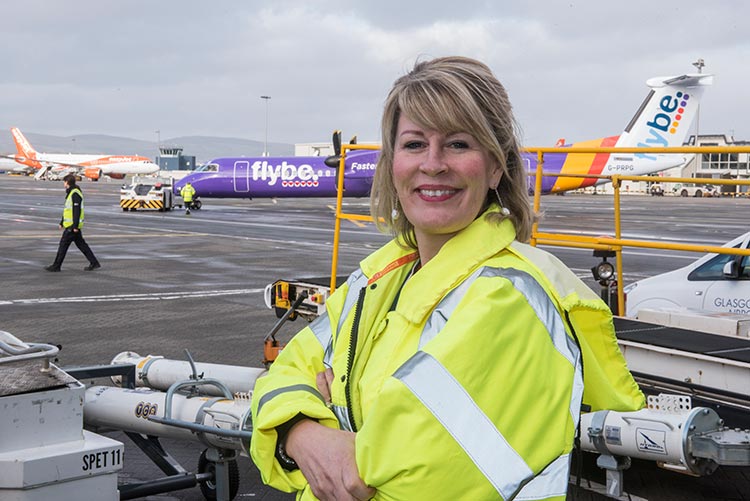
In 2018, the Scottish Government will introduce its new ‘Air Departure Tax’ (ADT). “We’re cautiously optimistic there will be a significantly lower tax, certainly the feedback we’re getting is that the Scottish Government will support a 50% reduction on long-haul flights.”
The obvious question to ask any senior director of a UK company these days, especially in Scotland where the ‘stay’ vote was overwhelming, is the impact on their business of Brexit. This is especially pertinent to Amanda McMillan, who is one of 18 business, economic and political experts appointed to the ‘Standing Council on Europe’, which will advise the devolved Scottish Government on the impact of Brexit.
“It’s no secret that Glasgow Airport and AGS lobbied publicly to stay. But the realities are that you just have to get on and look forward – hopefully we can preserve the privileges of the Common Aviation Area, and certainly the ministers we talk to – in both the UK and Scottish governments – think we will do, which, of course, is absolutely critical – we’ve not sensed anything to suggest that we’re not staying. Brexit is not what we wanted, but in business you need to be resilient to change, to look forward.”
Will Scotland slash Air Departure Tax?
Meanwhile, airports, and airlines operating in Scotland, are looking forward to the more immediate and direct impact of a significant reduction in taxation: From April 2018, UK Air Passenger Duty (APD) will be replaced with the Scottish Government’s new own powers to levy an ‘Air Departure Tax’ (ADT) for which a bill has now been introduced to the Scottish Parliament. UK taxes range from £13 to £450 (€15-€520) – rates which the governing Scottish National Party proposed halving when the new tax was first announced in 2015. Recently, the Scottish Government has been more reticent about ‘abolition’ or a big ‘reduction’ of a tax of which £300 million (€350m) was collected at Scottish airports in 2016 – a very attractive sum for the independently-minded Scottish Government.
“A year ago we were certainly very positive and we’re still cautiously optimistic that there will be a significantly lower tax,” says McMillan. “But we have to be realistic too, now that we are getting into the detail. The SNP manifesto said that they are going to abolish it when they can afford to do so, but the Scottish Government doesn’t have a majority, so there may have to be some compromise, some sort of a deal. Political action is supportive of an Irish-style drastic reduction because there is strong recognition of the downsides of the tax. The airlines have risen to the challenge too – Ryanair says it will increase capacity at Glasgow by up to a third. Certainly, the feedback that we’re getting is that the Scottish Government can support a 50% reduction on long-haul flights.”
Unserved route list gets shorter
While it is absolutely proven by many instances that airlines have curbed services due to very high UK aviation taxes, McMillan and her aviation team have still managed to recently cross many cities off the must-have list of routes. “We have just got two routes that I really wanted – Hamburg and Madrid – we especially wanted Madrid because of our Spanish shareholders (Ferrovial) – but European links still need more development – Brussels has been announced and we have Rome, but I would like to have more Rome frequency.”
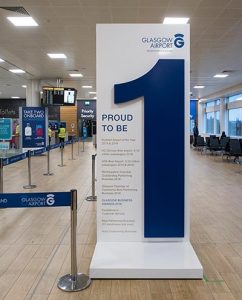
Number 1 at many things, including ACI EUROPE Best Airport in the 5-10 million category. Growth means that this year Glasgow Airport will likely need to compete in the 10+ million bracket.
The 2007-8 recession was particularly unkind to Glasgow, with the airport badly impacted by the demise of Flyglobespan, Zoom and XL Airways, contributing to a decline from a high of 8.8 million passengers in 2006 to 7.2 million in 2009. In 2016 the airport celebrated its 50th year – and a record 9.36 million.
While Ryanair made a high-profile entry with a new base in 2014, McMillan gives the big credit closer to home: “Jet2.com was the lynchpin in the turnaround and is now anchored in Scotland, particularly here in Glasgow with six aircraft – the new equipment [orders of 30 737-800s] is bringing around a change in strategy which is directly feeding back to us – higher utilisations, meaning that Jet2.com is much less seasonal.”
Despite the change in ownership and structure at AGS, which coincided with the Ryanair move, McMillan maintains: “Glasgow Airport has not changed – we still present the same opportunity. It’s not news to say that Ryanair changed their minds about which airports they wanted to work with, and when they become your partner they are good partners.”
While Jet2.com, Ryanair and easyJet are heavily contributing to the airport’s accelerating growth with the continued the development of point-to-point services, Glasgow Airport has become more interesting to other carriers attracted to scaled-up feed opportunities. A year ago Air France launched Paris services connecting Glasgow to the SkyTeam hub. McMillan says she does not view these developments with mixed feelings and that they do not make it harder to make the case for direct routes. “We will always need big hub connectivity. Indeed, the health of these services also serves to demonstrate the demand for the city and region – the more hubs we have connections to, the more we will develop. After all, we have offered Heathrow connections for half a century, now we also offer the considerable choice of onward connection with a twice-daily Emirates service. So, in fact, we chased Air France for five years. A year later the route sits well with easyJet – it’s very complementary.”
Supporting long-haul: ‘Glasgow does not tire’
Turning to more direct long-haul opportunities from Glasgow, McMillan says: “We would like to see more West Coast – Boston and Chicago – more Canada and, of course, something in Asia.” The airport has just announced that Korean Air will increase its charters to four rotations this year – a 25% increase. “We put a lot of effort into arranging these, perhaps at a risk that the effort could be seen as disproportionate, but the Korean Air service is a really good example of a big positive family effort across Scotland – everyone was really keen to see it happen. This engagement with people, agencies and other stakeholders underscores the ‘Scottish effect’ – we get the services, and we get a stepping stone to more business with Korea. Maybe we’ll get a seasonal route – and we get the lasting halo locally and on the other side of the world where we need to permanently market Scotland.”

Scotland’s Minister for Transport and the Islands Humza Yousaf celebrates the successful Korean Air charters, which return this year with a 25% capacity increase. “These services are a really good example of a big positive family effort across Scotland – the ‘Scottish effect’ – we get the services, and we get a stepping stone to more business with Korea. Maybe we’ll even get a seasonal route.” In other long-haul developments, Delta is starting a new seasonal daily New York JFK service in May.
Another SkyTeam carrier – Delta – is starting a new seasonal daily New York JFK service in May. “Delta has especially praised the way that ‘Glasgow does not tire’ in support for the new route. The airport and the city are indeed embedded – when we were struggling in 2010 we sat down with the city and championed a way of working together that is exceptional and seamless to the extent that today I chair the Glasgow Tourism and Visitor Strategy Board. This unique collaboration takes us over the line – we’ve won the Delta service and bookings are looking fine. It’s not going to be year-round yet – although United’s Newark services are – but we will set to work at extending the seasons with perhaps the route starting around Easter instead of May.”
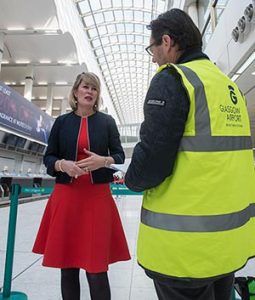
Talking to Airport Business – McMillan takes a significant collaborative steer as leader of the airport and also chair of Glasgow Tourism and Visitor Strategy Board: “Delta has especially praised the way that ‘Glasgow does not tire’ in support for the New York route, which launches in May.”
McMillan also reports that last year’s new Air Canada Rouge Toronto seasonal route performed well: “…their load factor was in the target range – and again there was a significant amount of onward connectivity – as much as 50% – heading anywhere from Calgary to New York. Air Canada is a powerful brand and we’re all working on its growth here in 2017.”
After last year’s very good year McMillan agrees: “We’re now into uncharted territory, as we’d never been above 9 million before. Some of our growth is ‘peaky’ – although becoming less so as our leisure market develops into what we call ‘summer holiday plus’ – with travellers taking the opportunity for incremental weekend breaks, as well as business.”
Glasgow’s growth rate sees it getting slightly ahead of itself – the current masterplan, drafted in 2011, forecast 10.4 million passengers in 2020, which it is now on course to reach about two years early. Improvements costing some £50 million (€60 million) are ongoing, but McMillan thinks that capacity will meet the challenge: “We have revised some projects, but the assumptions remain consistent in that we’ll avoid a second runway. We are, however, investing in additional stand capacity to the west of the airfield which will accommodate both Code E and Code C aircraft. The Glasgow City Deal Infrastructure Investment Programme will also see nearly £200 million (€230m) invested in creating a new rail link and an airport business park capable of accommodating up to 16 new aircraft hangars together with high quality logistics, manufacturing and office space.”
McMillan on the Tram-Train Glasgow Airport Access Project
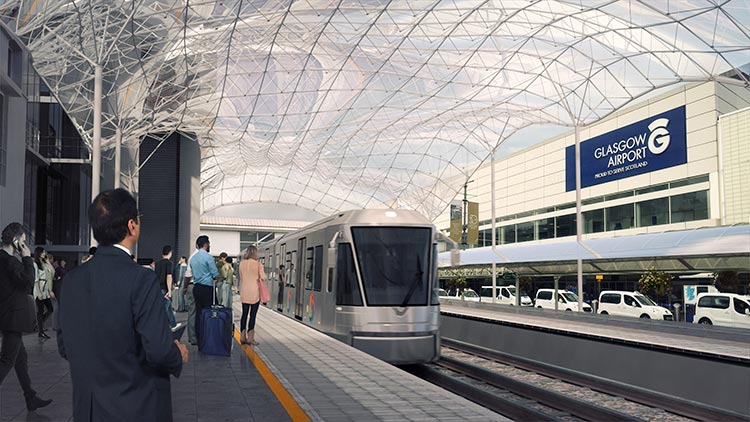
Announced in November 2016, the £144 million (€165m) Glasgow Airport Access Project will use the existing railway network, but will be linked to the airport by a new light rail spur when it opens in 2025. The hybrid tram-train approach is expected to deliver an airport rail link at a much-reduced capital cost than a purely tram, or ‘heavy train’ solution. McMillan is very happy about the deal: “I think the Tram-Train is great because it is tangible, it will pass by front doors, rather than being buried in a tunnel – yet it can drop on to heavy rail and use existing infrastructure, which is also faster than tram. We want to get car use down from 85%. Edinburgh Airport [which got its tram in 2014] is already achieving around 35% public transport access. Greater Glasgow is a large urban city (pop. 1.2 million) with a strong public transport ethos, including popular use of its subway system. I think we could be looking at usage as high as 50% for international travellers.”
AGS: ‘One group, three distinct airports’
AGS Airports was formed in 2014, after the airports of Aberdeen, Glasgow and Southampton were unravelled from Heathrow Airport Ltd (HAL). As well as being Managing Director of Glasgow Airport, McMillan is CEO of the whole AGS group – itself a partnership between Ferrovial, which remains a significant HAL shareholder, and Macquarie, which has major investments in the airports of Brussels, Copenhagen, Delhi, and Hyderabad.
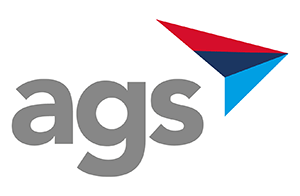
As well as boss of Glasgow, McMillan is CEO of the whole AGS Airports group which was formed in 2014 in a partnership between Ferrovial and Macquarie. The new AGS corporate image fuses the colours of the constituent airports – red for Aberdeen, dark blue for Glasgow, and light blue for Southampton.
McMillan says of AGS: “Our mantra is ‘one group three distinctive airports’ – we have no intention of running them at a group level – the airports are responsible for their own destiny.” As CEO McMillan says her job is “to assure myself – I look carefully at any plans – such as the multi-million pound 50% terminal extension at Aberdeen – I like to see what the airport boards are going to discuss, and I keep a close oversight of safety, but I’m a non day-to-day CEO of those airports, the local teams run them and we want to keep the passion local.”
However, McMillan says there are still AGS group benefits: “We have shared IT platforms and shared procurement. But in developing an AGS brand we don’t want to become an unwieldly group. I used to work for Diageo when that brand was created and it’s a very similar thing. Diageo was a strong corporate identity on many levels, but it did not drown out the brands such as Guinness and Smirnoff. In the same way people working for, and with, our 15 million passenger airport group will see that AGS means something will be done to a standard.”
There are also other benefits of an extensive network of common ownership: “I have people on my board involved in running airports from Heathrow to Hyderabad. This produces the chance to get some pretty good advice and shared experience, anything from digital advertising in Copenhagen, to questions about air bridges and how long our other shareholders took to get them… AGS is also asked for similar sharing.”
McMillan on Aberdeen and Southampton
Aberdeen Airport: The reduction in oil prices – down by more than half since 2012, has been a good thing for the aviation industry, but not for Aberdeen Airport which has been dominated by North Sea offshore oil and gas industry exploration. The airport has been hit hard, declining from a record high of 3.76 million passengers in 2014, to 3.01 million last year. However, 2017 has seen the first year-on-year growth (a modest 1% in February, but a considerable reversal of double-digit decline), although the decline in offshore helicopter movements (-10%) persists.
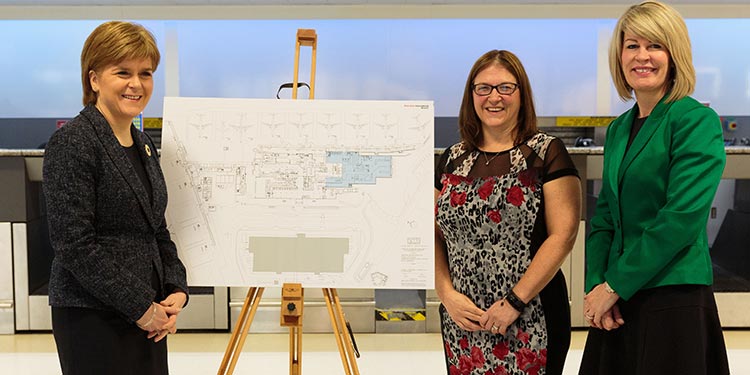
As AGS CEO McMillan says: “Our mantra is ‘one group three distinct airports’ but I do assure myself – I look carefully at any plans – such as the multi-million pound 50% terminal extension at Aberdeen.” (Unveiled here in 2016 along with Scotland’s First Minister Nicola Sturgeon, and Carol Benzie, Managing Director of Aberdeen Airport.)
McMillan forecasts: “It is unlikely that oil and the offshore industry will take Aberdeen back to where it was, but there are other opportunities. If you look at how the helicopters are now operating, they are providing changeovers to the rigs every three weeks instead of two because of cutbacks and competition. That also means that these same oil workers will fly in less frequently on airline services from the UK, Norway and elsewhere. This is a re-basing of the offshore operators’ cost base, and I do not think it will go back. But being more competitive is not a bad thing. And then you must look at other things in Aberdeen – tourism will get a considerable boost from the new conference and exhibition centre, while the proposed £11 billion (€13bn) mega-merger of Standard Life and Aberdeen Asset Management shows the importance and scale of its financial community.
Southampton Airport: Serving the UK’s famous south coast port city, Southampton Airport had 1.9 million passengers in 2016 – up 10% on 2015 (1.77m). McMillan defines the AGS desire: “We want to get Southampton back to 2 million – to concentrate on product and to make it as efficient as possible. Management is about being as strong as you can with your size and shape – and if there is a step-change needed at Aberdeen, Glasgow or Southampton, then AGS will do it.”
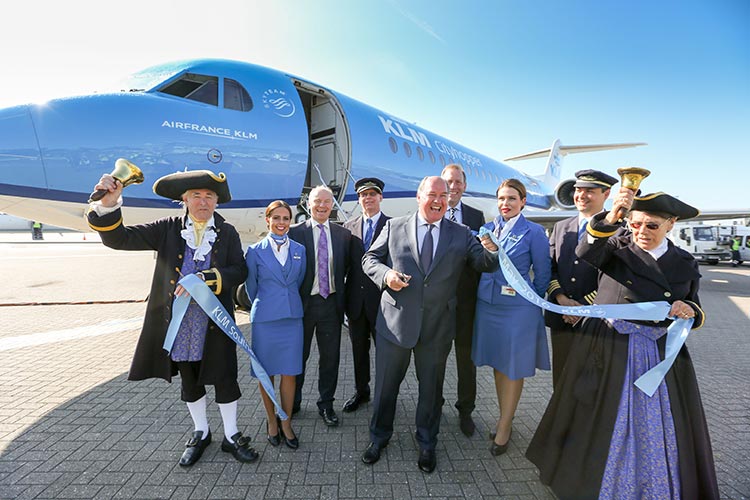
May 2016: KLM returns to Southampton, giving AGS key connectivity across five continents. “Management is about being as strong as you can with your size and shape – and if there is a step-change needed at Aberdeen, Glasgow or Southampton, then AGS will do it.”







